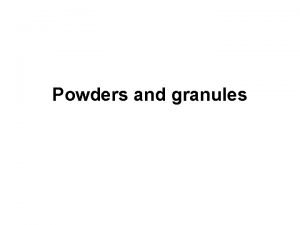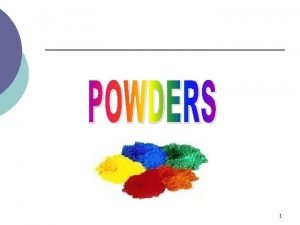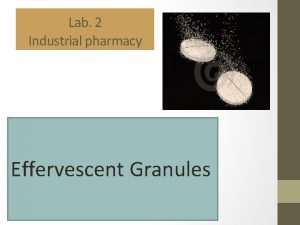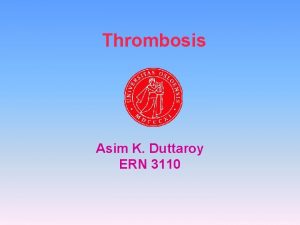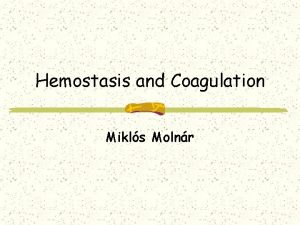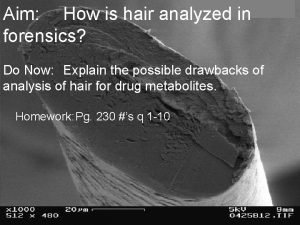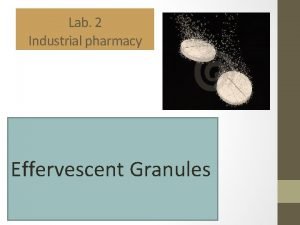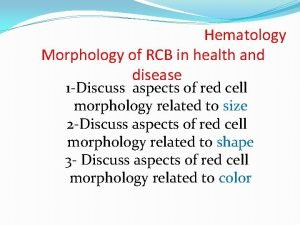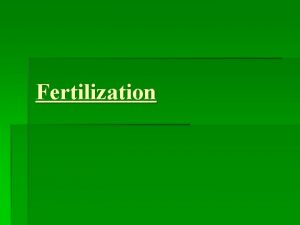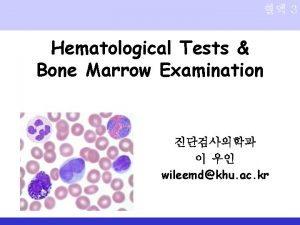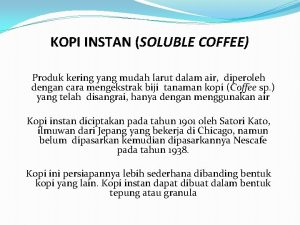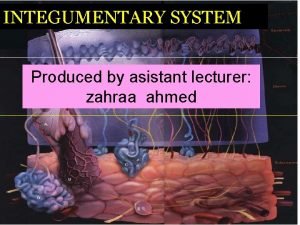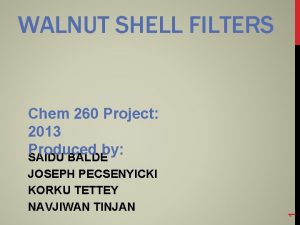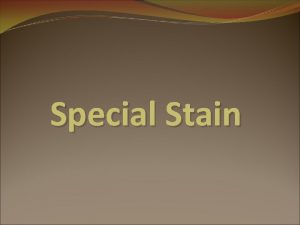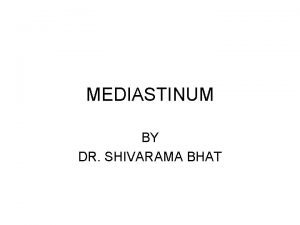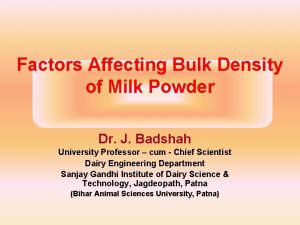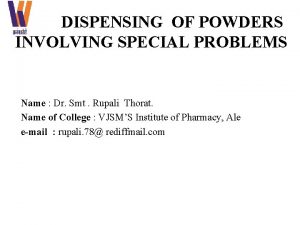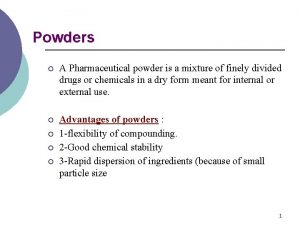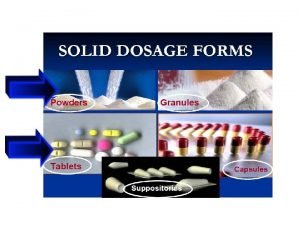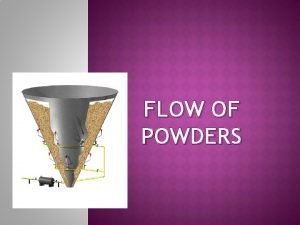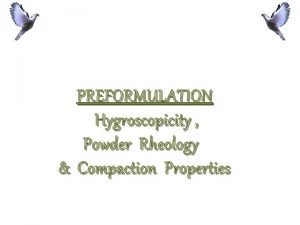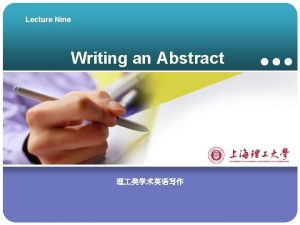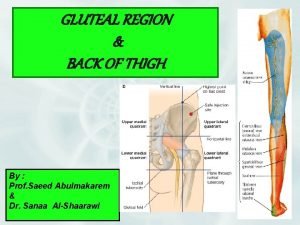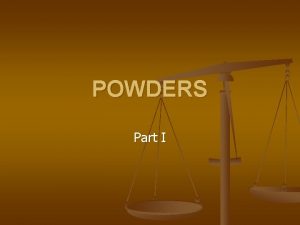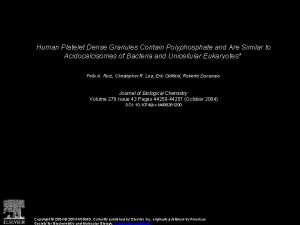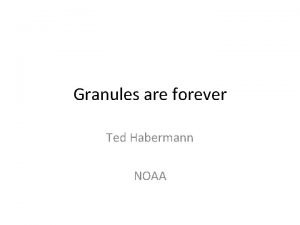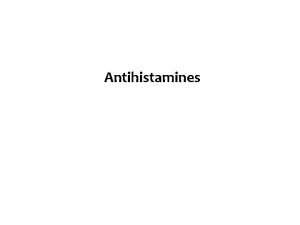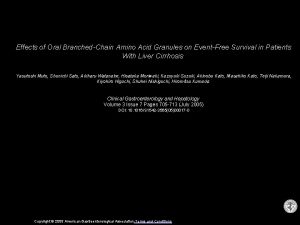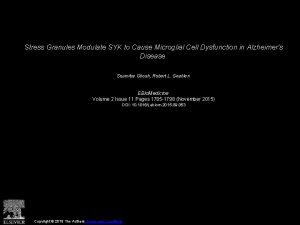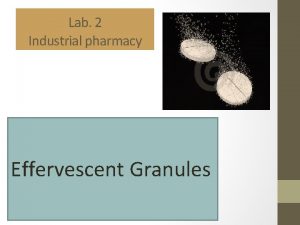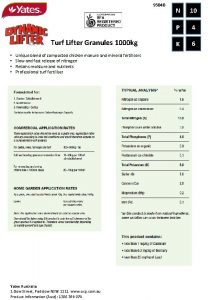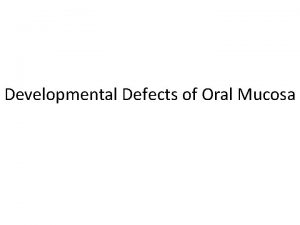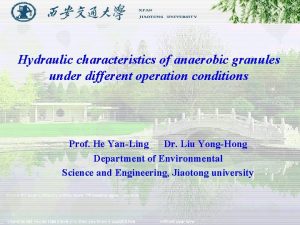5 Powders and Granules Contents I III Powders



































































- Slides: 67

5. Powders and Granules

Contents I. III. Powders Medicated powders Granules

I. Powders n n A dry substance composed of finely divided particles A medicated powder intended for internal (i. e. oral powder) or external (i. e. , topical powder) use.

n n Powders are intimate mixtures of dry, finely divided drugs and /or chemicals that may be intended for internal or external use. e. g. tablets, capsules, liquid dosage forms, ointments and creams.

Granules are prepared agglomerates of powdered materials, may be used per se for the medicinal value of their content or they may be used for pharmaceutical purposes, as in making tablets.

n n n n Before their use in the preparation of pharmaceutical products, solid materials first are characterized to determine their chemical and physical features including their morphology, purity, solubility, stability, particle size, uniformity, compatibility with any other formulation components.

一、Particle size and analysis

Powders of vegetable and animal drugs are officially defined as follows: - - Very coarse (No. 8): All particles pass through a No. 8 sieve (2. 36 mm) and not more than 20% through a No. 60 sieve (250 m). Coarse (No. 20): All particles pass through a No. 20 sieve (850 m) and not more than 40% through a No. 60 sieve.

- - - Moderately coarse (No. 40): All particles pass through a No. 40 sieve (425 m) and not more than 40% through a No. 80 sieve (180 m). Fine (No. 60): All particles pass through a No. 60 sieve (250 m) and not more than 40% through a No. 100 sieve (150 m). Very fine (or a No. 80): All particles pass through a No. 80 sieve. There is no limit to greater fineness.

The powder fineness for chemicals is defined as follows n n Course (or a No. 20) powder-All particles pass through a No. 20 sieve and not more than 60% through a No. 40 sieve. Moderately Course (or a No. 40) powder. All particles pass through a No. 40 sieve and not more than 60% through a No. 60 sieve.

n Fine (or a No 80) powder-All particles pass through a No. 80 sieve. There is no limit as to greater fineness. n Very fine (or a No. 120) powder-All particles pass through a No. 120 sieve. There is no limit as to greater fineness.

n Granules typically fall within the range of 4(4. 75 mm) to 12 -sieve size, although granulations of powders prepared in the 12 - to 20 -sieve (850 m) range are sometimes used in tablet making. n The purpose of particle size analysis in pharmacy is to obtain quantitative data on the size, distribution, and shapes of drug and nondrug components to be used in pharmaceutical formulations.

Particle size can influence a variety of important factors, including the following: 1) Dissolution rate of particles intended to dissolve; drug micronization can increase the rate of drug dissolution and its bioavailability. 2) Suspendability of particles intended to remain undissolved but uniformly dispersed in a liquid vehicle (e. g. , fine dispersions have particles approximately 0. 5 -10 m).

3) Uniform distribution of a drug substance in a powder mixture or solid dosage form to ensure dose-to-dose content uniformity. 4) Penetrability of particles intended to be inhaled for deposition deep in the respiratory tract (e. g. , 1 -5 m). 5) Lack of grittiness of solid particles in dermal ointments, creams, and ophthalmic preparations (e. g. , fine powders may be 50 -100 m in size).

A number of methods exist for the determination of particle size 1) Sieving Particles are passed by mechanical shaking through a series of sieves of known and successively smaller size and the determination of the proportion of powder passing through or being withheld on each sieve (range about 40 -9500 m, depending upon sieve sizes).

2) Microscopy in which the particles are sized through the use of a calibrated grid background or other measuring device. (range 0. 2 100 m)

3) Sedimentation rate in which particle size is determined by measuring the terminal settling velocity of particles through a liquid medium in a gravitational or centrifugal environment. (range: 0. 8 -300 microns) 4) Light energy diffraction or light scattering In which particle size is determined by the reduction in light reaching the sensor as the particle, dispersed in a liquid or gas, passes through the sensing zone (range 0. 2 500 microns).

5) Laser holography (激光全息照相术) In which a pulsed laser is fired through an aerosolized particle spray and photographed in three dimensions with a holographic camera, allowing the particles to be individually imaged and sized (range: 1. 4 100 micros). 用一束激光通过雾化粒子流,用全息照相术 拍三维照片,观察到粒子的形态和大小。

6) Cascade impaction (阶式碰撞) is based on the principle that a particle, driven by an airstream, will impact on a surface in its path, provided that its inertia (惯性) is sufficient to overcome the drag force that tends to keep it in the airstream. 当粒子用空气流输送时会撞击到一表面,假 定其惯性大于其向内的拉力,粒子流则会在 不同速率的空气流驱动下按不同的粒径分离。

Micromeritics (粉体学) n n n Micromeritics is the science of small particles. It is important to study particles because the majority of drug dosage forms are solids. Solids are not “static” systems-the physical state of particles can be altered by physical manipulation and particle characteristics can alter therapeutic effectiveness.

n n n n Micromeritics includes a number of charateristics including particle size distribution shape angle of repose porosity true volume bulk volume apparent density and bulkiness

Particle Size The microscopic method can include counting not fewer than 200 particles in a single plane using a calibrated ocular on a microscope.

n n The sieving method entails using a set of U. S. standard sieves in the size range desired. A stack of sieves is arranged in order, the powder placed in the top sieve, the stack shaken, the quantity of powder resting on each sieve weighed, and this calculation performed:

Angle of repose n The angle of repose is a relatively simple technique for estimating the flow properties of a powder. n It can easily be determined by allowing a powder to flow through a funnel and fall freely onto a surface n The height and diameter of the resulting cone are measured and the angle of repose calculated from this equation: tan =h/r where h is the height of the powder cone r is the radius of the powder cone.

Porosity, void, and bulk volume The characteristics used to describe powders include porosity, true volume, bulk volume, apparent density, true density, and bulkiness. Porosity is void 100% This value should be determined experimentally by measuring the volume occupied by a selected weight of a powder, Vbulk. The true volume, V, of a powder is the space occupied by the powder exclusive of spaces greater than the intramolecular space.

Void can be defined as (Vbulk-V)/Vbulk therefore, porosity is (Vbulk-V)/Vbulk 100% the bulk volume is true volume + porosity

Apparent density, true density, and bulkiness The apparent density, a, is Weight of the sample/Vbulk The true density, , is Weight of the sample/V The bulkiness, B, is the reciprocal of the apparent density, B=1/ a

二、Comminution of drugs n Grinding a drug in a mortar to reduce its particle size is termed trituration(研碎). n Mills and Pulverizers n Levigation is commonly used in small-scale preparation of ointments to reduce the particle size and grittiness of added powders. Mineral oil and glycerin are commonly used levigating agents.

Particle size reduction 1. Increase in number of particles If a powder consists of cubes 1 mm on edge and it is reduced to particles 10 m on edge, what is the number of particles produced? 1) 1 mm equals 1000 m 2) 1000 m/10 m=100 pieces produced on each edge; that is, if the cube is sliced into 100 pieces on the x-axis, each 10 m long, 100 pieces result.

If this is repeated on the y- and z-axes, the result is 100 100=1 million particles produced, each 10 m on edge, for each original particle 1 mm on edge. This can also be written [(102)3=106]. 2. Increase in surface area What increase in the surface area of the powder is produced by decreasing the particle size from 1 mm to 10 m? 1) The 1 mm cube has 6 surfaces, each 1 mm on edge. Each face has a surface area of 1 mm 2. Because there are 6 faces, this is 6 mm 2 surface area per particle. 3)

2) Each 10 m cube has 6 surfaces, each 10 m on edge. Each face has a surface area of 10 10=100 m 2. because there are 6 faces, this is 6 100 m 2, or 600 m 2 surface area per particle. Since 106 particles resulted from comminuting the 1 mm cube, each 10 m on edge, the surface are now is 600 m 2 106, or 6 108 m 2. 3) To get everything in the same units for ease of comparison, convert the 6 108 m 2 into square millimeters as follows. 4) Since there are 1000 m=1 mm, there must

This is more appropriately expressed as 106 m 2=mm 2. 6 108 m 2/106 m 2/mm 2=6 102 mm 2 The surface areas have been increased from 6 mm 2 to 600 mm 2 by the reduction in particle size of cubes 1 mm on edge to cubes 10 m on edge, a hundredfold increase in surface area. This can have a significant increase in the rate of dissolution of a drug product.

三、Blending powders Powders may be blended by spatulation( 搅拌法), trituration(研磨法), sifting(过 筛法), and tumbling(滚动法). 1) Spatulation is blending small amounts of powders by movement of a spatula through them on a sheet of paper or an ointment tile. Substances that form eutectic mixtures when combined include phenol, camphor, menthol, aspirin, phenyl salicylate, and other similar chemicals.

2)Trituration may be employed both to comminute and to mix powders. Geometric dilution method: - By this method, the potent drug is placed on an approximately equal volume of the diluent in a mortar and mixed thoroughly by trituration. - Then the second portion of diluent equal in volume to the mixture is added, and the trituration repeated. - This process is continued by adding equal volumes of diluent to the powder mixture and repeating until all of the diluent is incorporated.

This method - is used to ensure the uniform distribution of the potent drug. - is especially indicated when the potent and other ingredients are the same color and a visible sign of mixing is lacking.

3)Sifting n Sifting results in a light fluffy product. n This process is not acceptable for the incorporation of potent drugs into a diluent powder. 4) Tumbling n Mixing by this method is thorough. n are widely employed in industry.

II. Medicated powders 1) Internally (taken orally after mixing with water) - Local effects (laxatives) Systemic effects (e. g. , analgesics) 2) Externally (injection, vaginal douche) 3) Inhaled for local and systemic effects




1. n n n Aerosol powders (粉雾剂) Some medicated powders are administered by inhalation with the aid of dry-powder inhalers, which deliver micronized particles of medication in metered quantities. Therapeutic agent Inert propellants Pharmaceutical diluents The particle size of the micronized medication is prepared in the range of 1 to 6 m in diameter

2. Bulk and divided powders (多剂量和 分剂量散剂) 1) Bulk powders n Antacids (sodium bicarbonate) and laxatives (psyllium, 车前子); n Douch powders, dissolved in warm water by the patient for vaginal use; n Medicated powders for external application to the skin, usually topical anti-infectives (e. g. , bacitracin zinc and polymyxin B sulfate) or antifungals (e. g. , tolnaftate托萘酯);

n Brewer’s yeast powder containing B-complex vitamins and other nutritional supplements. n Dispensing powder medication in bulk quantities is limited to nonpotent substances. n Powders containing substances that should be administered in controlled dosage are supplied to the patient in divided amounts in folded papers or packets.

2) Divided powders After a powder has been properly blended, it may be divided into individual dosing units based on the amount to be taken or used at a single time. Each divided portion of powder may be placed on a small piece of paper that is folded to enclose the medication.

n n The selection of the type of paper is based primarily on the nature of the powder. If the powder contains hygroscopic or deliquescent materials, a water-proof or a waxed paper should be used. Powders containing volatile components should be wrapped in waxed or in glassine papers. Powders containing neither volatile components nor ingredients adversely affected by air or moisture are usually wrapped in white bond paper.

A number of commercially prepared premeasured products are available in folded papers or packets, including n headache powders n powdered laxatives n douche powders














III. Granules n n Granules are prepared agglomerates of smaller particles of powder. Granules are prepared by wet methods and dry methods. Moisten Powder or powder mixture Screen granules

Dry powder Roll compactor Granulating machine granules compression Powder mixture Large tablets slugs Granulated into the desired particle size

n Granules flow well compared to powders. For comparison, consider the pouring/flowing characteristics of granulated sugar versus powdered sugar. n Because of their flow properties, granulations are commonly used in tablet-making to facilitate the free flow of material from the feeding container into the tableting presses.

In addition to being free-flowing, granules have other important characteristics. n The surface area is less than a comparable volume of powder, granules are usually more stable to the effects of atmospheric humidity and are less likely to cake or harden upon standing. n Granules also are more easily “wetted” by liquids than are certain light and fluffy powders.

Granulated commercial products n Antibiotics n Laxative Senokot granules (Purdue Frederick) n Alka-Seltzer (Bayer)

1. Effervescent granulated salts n A medicinal agent n Sodium bicarbonate n Citric acid n Tartaric acid 1) Fusion method other powder citric acid crystals granules powdered a sieve mixing oven at 34 C to 40 C

2) Wet method - The wet method differs from the fusion method in that the source of binding agent is not the water of crystallization from the citric acid but water added to alcohol as the moistening agent, forming the pliable mass for granulation. - In this method, all of the powders may be anhydrous as long as water is added to the moistening liquid.

Questions 1. Why is particle size analysis important in pharmaceutical formulation? 2. How are powders of chemical drugs officially defined? 3. What are the methods for determination of particle size? 4. How to comminute the particle size of drugs? 5. How to blend powders? Simply describe each method. 6. What are medicated powders and how to apply them to the medication? 7. What are granules?How to prepare granules?
 Example of powder dosage form
Example of powder dosage form Define divided powders
Define divided powders Hamlet act iii scene iii
Hamlet act iii scene iii Granules dosage form
Granules dosage form Alpha granules of platelets
Alpha granules of platelets Morphology definition forensics
Morphology definition forensics Primary hemostasis
Primary hemostasis Is hair direct evidence
Is hair direct evidence Hair evidence
Hair evidence Pigment granules in hair
Pigment granules in hair Hair and fiber evidence
Hair and fiber evidence Granules pharmacy
Granules pharmacy Rouleaux formation
Rouleaux formation Cortical granules
Cortical granules Mast cells granules
Mast cells granules Tis granules
Tis granules Schuffner's granules
Schuffner's granules Coffee granules dissolve in water
Coffee granules dissolve in water Keratohylaine granules are found in
Keratohylaine granules are found in Google image
Google image Walnut shell filter
Walnut shell filter Periodic acid schiff stain principle
Periodic acid schiff stain principle Cause and effect contents of the dead man's pocket
Cause and effect contents of the dead man's pocket Parietal pericardium
Parietal pericardium Outlining and organizing the speech contents
Outlining and organizing the speech contents Elagse
Elagse Contoh serbuk gigi
Contoh serbuk gigi Milk powder bulk density
Milk powder bulk density Example of indiffusible powder
Example of indiffusible powder Define dusting powder
Define dusting powder Mystery powders lab
Mystery powders lab Finely divided, bulk effervescent
Finely divided, bulk effervescent Bulkiness of powder
Bulkiness of powder Hygroscopic powder example
Hygroscopic powder example Define career portfolio
Define career portfolio Deep perineal pouch contents
Deep perineal pouch contents Trali symptoms
Trali symptoms Febrile non hemolytic transfusion reaction
Febrile non hemolytic transfusion reaction Level of the sternal angle
Level of the sternal angle Screw home mechanism
Screw home mechanism Superior mediastinum
Superior mediastinum The immortal life of henrietta lacks table of contents
The immortal life of henrietta lacks table of contents Medial lemniscus
Medial lemniscus Triangular interval
Triangular interval Contents of the ark of the covenant
Contents of the ark of the covenant Anatomy of a comic book
Anatomy of a comic book Treitz ligament
Treitz ligament Mla table of contents
Mla table of contents Contents of stylistic lexis
Contents of stylistic lexis How to make school magazine cover page
How to make school magazine cover page Examples of continuous variables
Examples of continuous variables How to write a report example
How to write a report example Fresh frozen plasma vs platelets
Fresh frozen plasma vs platelets Occupied
Occupied Mediastinum blood supply
Mediastinum blood supply Abstract and introduction
Abstract and introduction Persepolis table of contents
Persepolis table of contents Persepolis table of contents
Persepolis table of contents Interactive notebook table of contents
Interactive notebook table of contents Cryopercipitate
Cryopercipitate Nuclei cerebelli
Nuclei cerebelli Spermatic cord coverings
Spermatic cord coverings Thigh region
Thigh region 5 w's event management
5 w's event management Contents of the middle mediastinum
Contents of the middle mediastinum Superior mediastinum
Superior mediastinum Contents of carotid sheath
Contents of carotid sheath Triangular space contents
Triangular space contents
